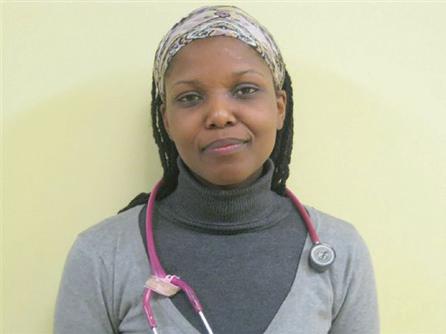




BELLVILLE
Dr N Mtimkulu
Dr MS Jacobs
Dr M Magopa
021 950 8930 021 945 2970
Dr T Isaacs 021 945 3483 021 110 5070
Dr Z Dunn 021 110 5059
TOKAI
Dr A Hendricks 021 712 2691
Dr T Motsema 021 110 5940
Dr M Tisane 021 023 2046
GATESVILLE
Dr N Allie 021 637 4323
Dr R Kader 021 638 2647
MITCHELLS PLAIN
Dr D Karangwa
Dr G Khobane
Dr T Masina
Dr O Orji
021 110 5064
Dr N Maseko 021 110 5157
RICHARDS BAY
Dr J Moodley
Dr MN Nkanyane
021 391 4297 021 391 4132/3 021 110 5945 035 772 1581 035 791 5506
Dr SMJ Zulu 035 791 5438
Dr M Tshimanga 035 791 5446
GATESVILLE & MITCHELLS PLAIN
Dr A Davids, Dr MA Jeeva & Dr H Khamissa
GATESVILLE: 021 637 1343/4
MITCHELLS PLAIN: 021 392 8141/0516
For more information contact us at info@melomed.co.za
Healthy eating for two
The ABC's of safe sleep
Your body & pregnancy
Contraception myths
Promoting skin-to-skin contact during c-section delivery
Breastfeeding


Healthy eating during pregnancy and breastfeeding is critical to your baby's growth and development. To get the nutrients you need, you must eat from a variety of food groups:

Sudden Infant Death Syndrome (SIDS) is the unexplained death of a seemingly healthy baby usually during sleep. Although the exact cause is unknown and all babies are vulnerable, certain sleep environments have been linked to an increased risk. By following these guidelines, parents can create a safe sleep environment for their babies, reducing the risk of sudden infant death syndrome (SIDS) and promoting safer sleep practices.
1. Always place your baby on their back for sleep
Placing babies on their back for sleep significantly reduces the risk of SIDS. This should be done for every sleep, and once babies start rolling from front to back on their own, they can find their own position for sleep.
2. Give your baby a clear, safe sleep space, in the same room as you
Babies should have a firm, flat mattress with no raised or cushioned areas. Pillows, quilts, duvets, bumpers, pods, nests, and sleep positioners should not be used. The baby's head should be kept uncovered, and the room temperature should be between 16 and 200C. Babies should be placed at the bottom of the cot (feet to foot) to prevent them from wriggling under covers. The sleep space should be kept clear of any items within reach, such as blind cords, soft toys, or nappy bags.
3. Babies should sleep in the same room as their parents or caregivers
Parents or caregivers should sleep in the same bed as the baby for the first few months, but not in the same bed.
4. Keep your baby smoke-free before and after birth
Smoking during pregnancy greatly increases the risk of SIDS. Pregnant women should make every effort to stop smoking, and partners should also quit smoking or avoid exposing the pregnant woman to second-hand smoke. Babies should be kept away from smoke in the home, car, and other environments.
5. Breast is best
Breastmilk and breastfeeding provide all the necessary nutrition for babies in the first six months and offer protection against infections and diseases. Breastfeeding also lowers the risk of SIDS. If additional help with breastfeeding is needed, midwives, and lactation experts can provide support.
6. Do not over-clothe baby while sleeping
Your baby should be warm but not sweating or hot to the touch. Ensure that the baby's head is kept uncovered to prevent overheating. Avoid using excessive blankets or bedding that can cause the baby to become too hot during sleep.
7. Never sleep with your baby on a sofa or armchair
Sleeping with a baby on a sofa or armchair is extremely dangerous and increases the risk of SIDS. If there is a risk of falling asleep, it is best to move to a safer sleep space, such as a cot.
Source: www.unicef.org.uk/babyfriendly







Pregnancy affects and can wreak havoc on every part of your body - from your hair to your toenails. Beyond the weight gain, swollen ankles and hot flushes, so many things are changing during those 9 months. Here are a few surprising facts about your pregnant body.
YOUR PREGNANCY GLOW
Your skin's oil production rises
WHEN CONSUMING FOOD baby gets food before you do
YOUR BONES SOFTEN from high levels of hormones oestrogen and relaxin
Due to extra workload YOUR HEART GROWS and organs enlarge
50% MORE BLOOD FLOW to your bladder causes it to fill faster
A woman will spend an average of 8.22 HOURS IN LABOUR
FOOD CRAVINGS are experienced by more than 70% of pregnant women
Women only need about 300 EXTRA CALORIES per day while pregnant
HAIR GETS THICKER due to the oestrogen receptors it contains
90% of women experience CHANGE IN SKIN TONE
70-80% of women experience MORNING SICKNESS
Pregnant women and new mothers can LACTATE AUTOMATICALLY when they hear a baby crying (even if it's not their own)
UTERUS STRETCHES and expands up to 500 times its normal size
AMNIOTIC FLUID is mostly sterile urine
YOUR WOMB holds half a liter of water
'GROWING' FEET due to extra fluid and water retention they can grow up to one shoe size
22.5 12kg 61% 10
the average age for a South African woman to give birth for the first time of women receive an epidural or spinal anaesthesia for vaginal deliveries is the average weight women gain during pregnancy women get pregnant every second worldwide

WHAT YOU NEED TO KNOW ABOUT THE “PILL” AND MORE.
When it comes to contraceptives, there are many options available. Contraceptives can give you the freedom and peace of mind to protect yourself from unplanned pregnancies and sexually transmitted infections (STIs). Access to contraceptives allow you to decide if, when, and how to start your family, giving you control over your reproductive health, wellness, and future. Good health, in turn, enables you to live your life to the fullest.
Today, many people use contraceptives, but there are still myths and misconceptions about different methods. Some people may avoid using them due to fears of possible side effects and negative beliefs about contraception.
Using contraception is a highly personal choice and everyone should be informed to make the best decisions for their reproductive health. Here, we debunk six common contraceptive myths to help you make informed decisions for your health and future.
Myth 1: The contraceptive pill/birth control pill is effective immediately after taking it.
Fact: It is important to take you birth control as prescribed by your healthcare provider. For example, for pregnancy prevention, the contraceptive pill needs to be taken every day at the same time.
Myth 2: Contraceptives, like IUDs, are responsible for infertility.
Fact: Also known as a ‘loop,’ an intrauterine device (IUD) is a small device shaped like a "T" that fits inside your uterus. There are two types of UIDs: copper and hormonal, which prevents sperm from reaching the egg. Contraceptives like IUDs are very effective, and they last for 3-5 years. These contraceptives do not cause infertility. A female can fall pregnant immediately after removing an IUD. After inserting the IUD, it is important for female clients to come for two check-ups, one at 6 weeks and another after 1 year.
Myth 3: Contraception is a woman’s responsibility.
Fact: Women are often scared to speak to their partners about contraceptives, but women and men have an equal responsibility to use contraceptives to protect themselves from HIV, STIs and unwanted pregnancies. If you are male speak to your healthcare provider about medical male circumcision, vasectomies, and the use of condoms to protect yourself and your partner.
Myth 4: You don’t need to use other forms of protection if you’re on the pill.
Fact: Remember, you need to use a condom every time you have sex to protect yourself from sexually transmitted infections, as the pill cannot protect you from contracting an STI. This is why “double protection” is important. Double the protection means double the safety against STIs, including HIV. Dual protection – using condoms while using other contraceptives, like the pill, too – ensure good reproductive health for you and your partner.
Myth 5: I can’t become pregnant while breastfeeding.
Fact: It is possible to get pregnant while breastfeeding. The good news is that you can protect yourself from unplanned pregnancies. When breastfeeding exclusively, it is less likely for a woman to ovulate until she starts to wean the baby from the breast. When breastfeeding is supplemented with formula or solids, even when the period has not returned yet, and there is no contraceptive protection, the woman can fall pregnant. To prevent pregnancy while breastfeeding, it is best to start another form of contraception soon after delivery even if you are breastfeeding.
Myth 6: I can take my morning after pill at any time.
Fact: Like the daily oral contraceptive, it’s important to take your emergency pill or morning after pill as advised by your healthcare provider. The emergency contraception or the ‘morning after’ pill can prevent unwanted and unplanned pregnancies. Remember to take it within the 72 hours of having unprotected sexual intercourse. You can get it for free at primary health care (clinic) facilities. Ask your healthcare provider where to access the morning after contraceptive.
There are many contraceptive options available to you. Whether you’re planning for a family or want to protect your reproductive health, using the correct method of contraception is important. These methods include:

Oral contraceptives:
Commonly known as "the pill", this must be taken daily, and is available free of charge at clinics and hospitals. It does not prevent sexually transmitted infections (STIs).

Implant contraceptive:
The implant contraceptive is a tiny white plastic rod that is inserted under the skin of the inner, upper arm to prevent pregnancy. The implant is effective for three years, after which it should be removed and replaced with a new one. The contraceptive implant is more than 99% effective at preventing pregnancy, making it one of the more popular birth control methods. It does not protect against STI’s.

Contraceptive injection for women:
There are two types: Nur-Isterate, which is given every two months (eight weeks), and DMPA (Depo Provera or Petogen), which is given every three months (12 weeks). This form of contraception does not prevent STIs.

Intrauterine Device (IUD):
An IUD is a small device that is put into a women's uterus (womb) by a specially trained health worker. An IUD can prevent pregnancy for a number of years. It does not prevent STIs. If a woman or her partner has multiple sex partners, the IUD should not be the method of first choice unless condoms are also used to protect against STIs.
Source: www.westerncape.gov.za/site-page/family-planning

Available free of charge at clinics (female condoms are available at designated clinics). It is the only single method that offers dual protection from both unwanted pregnancy as well as STIs including HIV/AIDS.

Sterilisation:
This is a short and simple operation but is a permanent contraceptive method for both males and females. Any person 18 years or older who is capable of consenting may be sterilised at their request. Sterilisation does not prevent STIs. As with all contraceptive methods, there is a small risk of failure.

By Dr Jayeshnee Moodley
Childbirth is a profound experience, and the moments immediately following delivery are crucial for both mother and baby. Skin-to-skin contact during delivery is a world-wide phenomenon which improves both maternal and newborn outcomes. While skin-to-skin contact has long been advocated for vaginal births, its significance during C-section deliveries is equally important.
“This is a landmark in Zululand as Melomed Richards Bay is the first hospital in Zululand to offer this lifechanging process. I am proud to work with a team of midwives, paediatricians and anaesthetist that share my passion and vision for improving the delivery experience emotionally, mentally and physically.”
Once both mum and baby are deemed well, skin-to-skin contact is initiated immediately in theatre and continues until discharge from hospital. It is well-documented that skin-toskin contact after delivery provide numerous health benefits for both mother and baby:
It improves oxygen saturation: Skin-to-skin contact has been shown to improve oxygen saturation in newborns, which is especially important for preterm babies.
It regulates body temperature: Newborns have a hard time regulating their own body temperature, and skin-to-skin contact helps to keep them warm.
It stimulates digestion: Skin-to-skin contact can help stimulate digestion and an interest in feeding, which is important for newborns to get the nutrients they need.
It reduces cortisol levels: Skin-to-skin contact has been shown to reduce cortisol levels in newborns, which can help reduce stress.
It encourages breastfeeding: Skin-to-skin contact can help encourage breastfeeding, as it allows the newborn to find the breast and self-attach.
It improves bonding: Skin-to-skin contact can help improve bonding between the newborn and their caregiver, as it allows for close contact and interaction.
It reduces pain: Skin-to-skin contact has been shown to reduce pain in newborns and mums during their delivery.
It supports development: Skin-to-skin contact can help support development, as it allows the newborn to feel secure and comforted.
"My passion is women’s health and I strive daily to ensure that birthing is both a safe and nurturing experience for mum and baby."
ABOUT THE AUTHOR

DR. JAYESHNEE MOODLEY
MBChB, FCOG (SA), MMed (O&G), AHMP (YALE)
Dr. Moodley is a(n) Obstetrician/Gynaecologist and currently practices at Melomed Richards Bay.
Tel: 035 772 1581
Email: jayeshnee.moodley@gmail.com
Breastfeeding myths can change the course of your individual journey, whether you’re a new mom or a seasoned pro. Here, we debunk the most common breastfeeding tales and reveals their surprising truths.
MYTH #1:
BREASTFEEDING ISN’T THAT DIFFERENT TO FORMULA MILK
FACT :
The two milks are VERY different. Formula is essentially cows' milk, and may contain around 30 beneficial ingredients, while breast milk has about 300. Breastfeeding is not just the best, but, it is the biological norm. It is the foundation of normal development in all areas of human health. It is the building block of not only today’s healthy baby, but also tomorrow’s healthy adult.
MYTH #2:
BREASTFEEDING TIES THE MOTHER DOWN
FACT :
It depends on how one views it. A baby can be breastfed anywhere and at any time – no need to drag around bottles or formula, no need to worry about sterility or warming up the milk. All of this is very liberating for the mother.
IT IS MORE CONVENIENT TO FORMULA FEED THAN TO BREASTFEED
FACT :
This should not be true, in most cases. However, breastfeeding is made challenging when women do not receive the help they should to get started properly. Breastfeeding is often difficult in the beginning; therefore, it is vitally important that mothers should be given the correct information and support before and after birth. Breast milk is always the right temperature, it requires no mixing or preparation, it is ready when baby is, and it is free. It changes in nutrient composition for the age of the child. The supply will adjust according to the needs of the infant. Breastfeeding is not only a great financial saver, but it is also an environmentallyfriendly practice.
NEWBORN BABIES SHOULD BE GIVEN TO THE MOTHER TO HOLD IMMEDIATELY AFTER DELIVERY. THEY SHOULD HAVE SKIN-TO-SKIN CONTACT WITH THE MOTHER AND BEGIN BREASTFEEDING AS SOON AS POSSIBLE AFTER BIRTH.
NEWBORN BABIES AND MOTHERS SHOULD BE SEPARATED IMMEDIATELY AFTER DELIVERY
FACT :
Not true! Newborns should be given to the mother for immediate skin-to-skin contact and breastfeeding. This helps stimulate breast milk production, aids the mother's womb in contracting (reducing the risk of heavy bleeding or infection), and helps expel the placenta. Early breastfeeding, ideally within the first six hours, increases the chances of success and improves milk supply. Breastfeeding works on a supplyand-demand basis, so frequent early feeds are crucial for establishing a good milk supply. Regular, frequent breastfeeding stimulates milk production, ensuring a healthy supply later on.
FACT :
Babies are not confused; they know exactly what they want. If a baby experiences slow milk flow from the breast and rapid flow from a bottle, they will quickly notice the difference. A baby who has only been breastfed for three or four months is unlikely to take to a bottle easily. Some babies prefer one breast over the other, just as bottle-fed babies may favour one type of artificial teat. So, we see that there is such a thing as preferring one nipple to another.
Nipple preference can develop after just one or two bottle feedings. Introducing an artificial nipple can worsen latch issues rather than improve them. Those who dismiss nipple confusion often recommend introducing a bottle too early. Bottles can interfere with breastfeeding, especially if introduced within the first three to four weeks when breastfeeding is still being established. Breast and bottle feeding require different oral-motor skills, leading some babies to develop sucking confusion by using inappropriate techniques when switching between the breast and the bottle.
Source: Unicef - www.unicef.org/parenting/food-nutrition/14myths-about-breastfeeding
Melomed Hospitals have specialist doctors to treat all your baby’s sickness and ailments.
From our specialised Paediatricians, Neonatologist, Ear, Nose & Throat (ENT) specialists to Baby Clinics.

Melomed Gatesville & Tokai
Dr S Raban 021 023 0604 021 637 2358

Melomed Richards Bay
Dr KP Seake 035 791 5428

Melomed Gatesville Dr R Khan 021 637 3811/3817

Melomed Bellville Dr M Bassier 021 391 0199

Melomed Mitchells Plain Dr O Adam 021 391 4967/8
Melomed Gatesville Dr M Ismail 021 633 0332


Melomed Richards Bay Dr S Chetty 035 791 5535

Melomed Bellville Dr D Rhode 021 945 1898


Melomed Tokai
Dr R Moore 021 110 5941
Melomed Tokai
Dr M Meyer 021 712 1643
Melomed Mitchells Plain Dr MW Mathure 021 110 5145


Melomed Bellville Dr M Ledger 021 946 1347




Melomed Gatesville & Tokai
Dr. J Stulinski 021 712 5346 / 021 761 4909 021 638 3150/46

Melomed Bellville
Dr. A Behr 021 945 1502

Melomed
Gatesville & Tokai
Dr. S Ebrahim 021 637 7772 021 202 6307

Melomed Bellville
Dr. Z Doolarkhan 021 946 2191

Melomed Mitchells Plain
Dr. W Makhaye 021 110 5950

Melomed Bellville
Dr. Raphael Mlauzi 021 110 5217

Melomed Richards Bay
Dr. L Setoaba 035 791 5440
RHO Clinic at Melomed Bellville Hospital, Suite 12 on the First floor - Tel: 021 950 8960
The following services are rendered:
1.Follow up on newborn babies from the age of 2 weeks.
2.Immunisations of babies
3.Family planning
4.Asthma education
5.Responsible for doing lung functions for the pulmonologist.
6.Breastfeeding Education
Clinic Hours:
Mondays to Thursdays: 9:00 - 16:00, Fridays: 9:00 - 13:00
Open some Saturdays as per request and by appointment only.
Dr Raban at Melomed Tokai - Tel: 021 023 0604
The following services are rendered: -Vaccinations
-Breastfeeding consultation -Circumcision
-Family Planning
-Paediatric Consultation

Respiratory syncytial virus (RSV) causes infections of the lungs and respiratory tract. RSV can cause severe infection in some people, including babies 12 months and younger, especially premature infants, older adults, people with heart and lung disease, or anyone with a weak immune system (immunocompromised).
Signs and Symptoms
Signs and symptoms of RSV infection most commonly appear about four to six days after exposure to the virus. Infants are most severely a ected by RSV. Signs and symptoms of severe RSC infection in infants include:
• Short, shallow and rapid breathing
• Unusual tiredness
• Irritability
• Poor feeding
• Cough
• Struggling to breathe
Causes
Respiratory syncytial virus enters the body through the eyes, nose or mouth. It spreads easily through the air on infected respiratory droplets. You or your child can become infected if someone with RSV coughs or sneezes near you. The virus also passes to others through direct contact, such as shaking hands. The virus can live for hours on hard
surfaces or objects such as countertops, crib rails and toys. If you touch your mouth, nose or eyes after touching a contaminated object and you're likely to pick up the virus.
An infected person is most contagious during the rst week after infection. But in infants and those with weakened immunity, the virus may continue to spread even after symptoms go away, for up to four weeks.
Risk factors
Children at increased risk of severe or sometimes life-threatening RSV infections include:
• Infants, especially premature infants or babies who are 6 months or younger
• Children who have heart disease that's present from birth (congenital heart disease) or chronic lung disease
• Children or adults with weakened immune systems from diseases such as cancer or treatment such as chemotherapy
• Children who have neuromuscular disorders, such as muscular dystrophy

